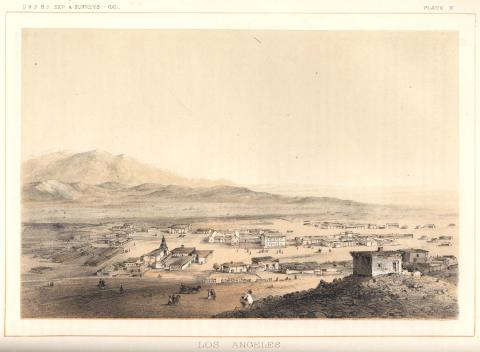Biographies | Newspapers | Images | Maps
As part of its strategy to gain control of Mexico's northern provinces, the War Department ordered Colonel Stephen Watts Kearny to seize New Mexico.
In June 1846, Kearny led 2,500 men out of Fort Leavenworth, Kansas. During the course of the next two months the "Army of the West" marched 850 miles to Santa Fe. Although Governor Manuel Armijo exhorted residents of the province to repel the invasion, he fled to Chihuahua as Kearney's force approached, allowing to U.S. troops to take the town without resistance in mid-August.
Promising to respect New Mexican property and religion, Kearny established a legal code for New Mexico and installed Charles Bent, an American trader, as territorial governor. Kearny now received new orders from Washington, promoting him to the rank of brigadier general and instructing him to aid in the conquest of California.
Dividing his forces, Kearny left 800 men under Colonel Sterling Price to occupy New Mexico, and ordered Alexander W. Doniphan to march south with a second contingent of 800 men to El Paso. With 300 dragoons Kearny set out for California in late September, 1846. Believing that land and sea forces under Frémont and Commodore Robert F. Stockton had already secured California, Kearny sent 200 dragoons back to Santa Fe, taking the remainder on a grueling 2,000 miles journey, much of it through the Sonoran desert.
As Kearny headed west, resistance to U.S. rule flared in California. As his small force approached San Diego, where it planned to link up with Stockton's marines, Kearny's weary dragoons encountered a force of 150 Californios. At the Battle of San Pascual on December 6, Kearny was seriously wounded and 18 of his men killed. The force was rescued the following day by the timely arrival of a relief column led by Stockton.
In January, 1847 a combined U.S. force of about 600 men--consisting of Kearny's dragoons, Stockton's marines, and Frémont's California Battalion-- regained control of Los Angeles, prompting Californio elites to sign the Treaty of Cahuenga, which ended the fighting in Upper (Alta) California.
With peace established, a feud arose among the three leaders of the U.S. forces. Having been tapped by Stockton to serve as territorial governor, John C. Frémont refused to give up his post to Kearny, who outranked him. Not until the arrival of additional U.S. troops did Frémont relinquish his post. Kearny appointed his own territorial military governor and ordered Frémont to accompany him back to Fort Leavenworth, Kansas. Frémont was later court-martialed for insubordination, but political connections?he was the son-in-law of Democratic senator Thomas Hart Benton?prompted President Polk to commute the sentence.

